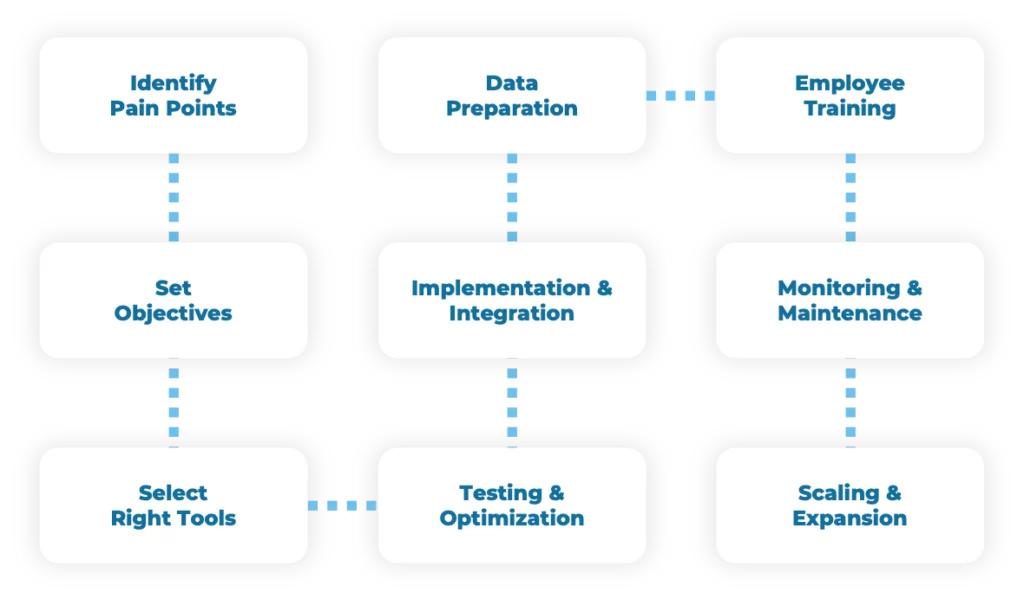Leveraging AI to Increase Efficiency and Cost Optimizations
Regardless of your industry, you’re no stranger to the frustrations of repetitive tasks, time-consuming operations, and the relentless pace that leaves little room for strategic thinking. Manual or inefficient processes often result in bottlenecks, errors, increased costs, and decreased productivity, leading to several pain points, such as:
- Manual Repetitive Tasks: Many processes involve mundane, repetitive tasks that consume valuable employee time and are error-prone.
- Data Entry Errors: Manual data entry is susceptible to errors, which can lead to costly mistakes and delays.
- Inefficient Workflows: Complex processes often involve convoluted workflows that can be slow and cumbersome.
- Lack of Visibility: Limited visibility into process status can make it challenging to track progress and identify bottlenecks.
This is where AI steps in. AI-driven robots or bots can be programmed to handle routine, repetitive tasks, freeing up employees to focus on more strategic work or AI can use natural language processing (NLP) and machine learning to extract and validate data accurately, minimising errors. Workflow processes can be analysed and optimised by several existing market solutions to ensure tasks are completed efficiently, reducing redundancy and delays within a few clicks.
How AI Can Transform Your Hiring Process
Lets take this one step further and see how AI can truly increase efficiency by looking at a normal Recruiting process. We all know that finding the right talent for your business is a monumental task. Whereas before your were overwhelmed with a massive pile of applications, AI can sift through them in a flash. It scans resumes, evaluates candidates, and even screens for qualifications based on your specific criteria. You get a shortlist of the most promising candidates without breaking a sweat.
And it’s not just about the speed, but also the quality. We all know that the right candidate isn’t always the one with the most dazzling resume. Sometimes, the perfect fit is the hidden gem with unique experiences or skills. AI excels at spotting these unconventional candidates. It can analyze the nuances of a candidate’s background, connecting the dots that a human might miss. This means you don’t just hire based on what’s on paper but on the full potential each person brings to the table, while also using one of the most remarkable features of AI in recruiting – its ability to eliminate bias. This levels the playing field, giving each candidate an equal opportunity to shine based solely on their qualifications and potential. It’s not about who you are but what you can bring to the team.
With the adoption of AI in the recruiting process, companies such as Unilever have managed to cut over 70,000 person-hours of interviewing and assessing candidates, massively increasing their efficiency as well as reduce the hiring costs.
Implementing AI Solutions
To effectively adopt AI-powered process automation, organizations require a strategic approach and a clear understanding of the processes to be automated and the desired outcomes. Here at Occam, we follow some essential considerations for businesses looking to adopt AI-enhanced BPA:

- Identify Pain Points: Start by identifying specific pain points within your processes. Determine which tasks are repetitive, error-prone, or time-consuming.
- Set Objectives: Clearly define the goals and objectives you aim to achieve through automation, such as reducing costs, improving efficiency, or enhancing customer experiences.
- Select the Right Tools: Choose AI automation tools or platforms that align with your organization’s needs and processes. Several tools can be used such as UiPath, MS Power Automate, Blue Prism, amongst many more.
- Data Preparation: Ensure that your data is clean, structured, and accessible. AI relies heavily on data for training and decision-making.
- Implementation and Integration: Work together with AI specialists to implement automation solutions seamlessly into your existing processes and systems. Integration with existing software is critical for a smooth transition.
- Testing and Optimization: Thoroughly test the AI automation system to identify and resolve any issues. Continuously optimize the system to improve its performance.
- Employee Training: Provide training to employees to help them understand the new processes and how they will work alongside AI automation.
- Monitoring and Maintenance: Regularly monitor the AI automation system’s performance and address any issues promptly. Updates and maintenance may be necessary to keep the system efficient and secure.
- Scaling and Expansion: As you experience success with initial automation, consider expanding its use to other areas of your organization’s operations.
Conclusion
AI-powered process automation holds the potential to transform organizations by addressing common pain points, reducing costs, and improving operational efficiency. By identifying specific pain points, setting clear objectives, and following a systematic approach to adoption, organizations can harness the power of AI to streamline their processes and gain a competitive edge in today’s dynamic business environment. Embracing AI-driven process automation is a strategic move that can lead to long-term benefits and growth.
Sources:
- David L. Rogers, The Digital Transformation Playbook
- Bernard Marr, The Amazing Ways How Unilever Uses Artificial Intelligence To Recruit & Train Thousands Of Employees




